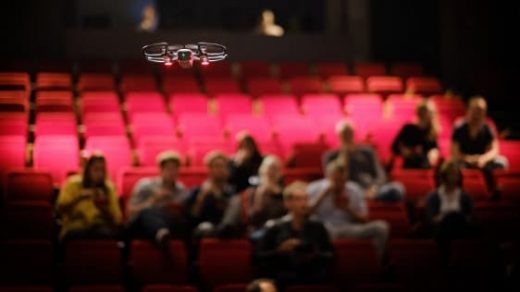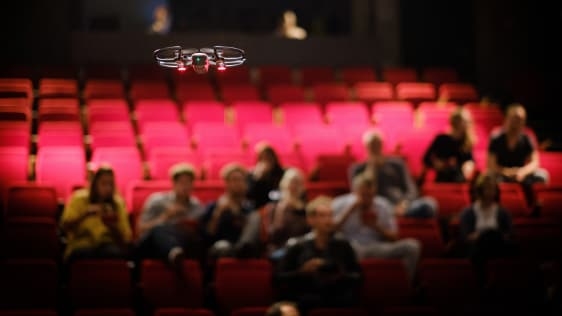This Startup Could Help Protect Against Drone Attacks On Stadiums Or Companies
While drones can be a lot of fun to fly recreationally, and are increasingly being used to take stunning aerial photography, there are many who worry about how they can be used for nefarious purposes.
Already, people have been employing drones as a way to sneak contraband into prisons, and in some cases in terrorist attacks on military personnel. Now, there are those who worry about things like drones being used for corporate espionage, to contaminate municipal water supplies, or to attack big open-air events, like football games.
One of the most promising new areas in the drone industry is developing technology that can detect rogue drones. And while it may be up to lawful authorities to take the actual countermeasures that bring down drones being used for bad acts, these new companies say they can give their customers the kind of information that can help protect them.
That rationale is why John Chambers, the former CEO of Cisco, is now an investor in, and advisor to, San Francisco-based Dedrone, a startup that’s building a technology architecture meant to detect badly behaving drones and help customers automatically distinguish them from those being operated by everyday hobbyists.
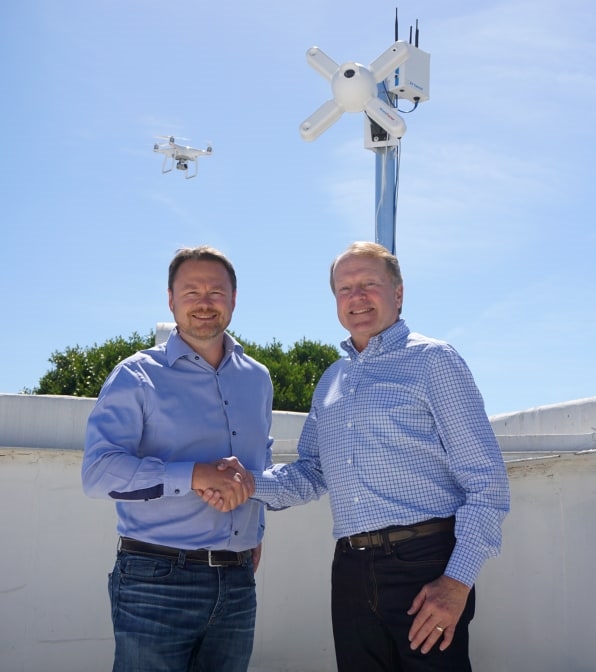
Last year, Dedrone raised a $15 million B round of funding led by Felicis Ventures and Chambers’s new JC2 Ventures. The new investment firm, just unveiled (January 21, 2018), has put money into eight initial portfolio companies that are “changing the world and innovating ahead of major market transitions.” The others are Airware, Aspire, OpenGov, Pindrop, Privor, Sprinklr, and Uniphor. Chambers recently spoke exclusively to Fast Company about Dedrone.
Already, Dedrone has worked with an impressive list of clients that include the World Economic Forum in Davos, Switzerland, the U.S. Army’s Joint Base Myer Henderson Hall in Washington, D.C., the Georgia Department of Corrections, and provided drone detection services for some of the Clinton-Trump presidential debates and the NBA’s Golden State Warriors’ championship parade in Oakland, California, last June. “There’s not a single installation we’ve done,” Dedrone CEO Jorg Lamprecht says, “where we do not see a drone within the first 24 hours.”
The key is to decide whether those drones are harmless or threatening.
The implementation of Dedrone’s technology is different for each client, but in general, it’s built around a series of off-the-shelf sensors, cameras, and microphones, and proprietary software that evaluate local airspace in order to detect any drone activity within a radius of about a mile, and do so while the devices are still in the air. Combining data collected by those sensors and cameras with artificial intelligence, the company’s systems are able to do pattern recognition and pattern detection that, in theory at least, can determine whether a drone flying by is harmless or has ill intent. Or tell the difference between a drone and a bird, and do so in any kind of weather conditions.
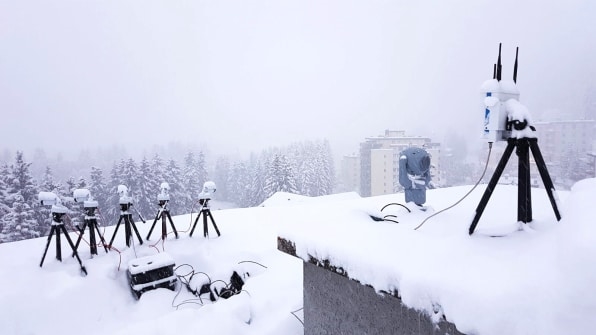
Once a drone is confirmed detected, the software then collects as much intelligence about it as possible–things like its manufacturer, model, where its pilot is, and even what it’s carrying. All in real time. The technology doesn’t do anything to actually stop incoming drones–just detection, triangulation, reporting, and alerting.
To Lamprecht, there are at least two totally different kinds of situations that Dedrone is trying to detect. The more dangerous, of course, is a terrorist trying to use drones to attack big events or military units. But the company also believes there’s going to be a surge in the coming months and years of the flying robots being utilized for things like spying through companies’ windows or dropping sniffing devices on institutions’ rooftops.
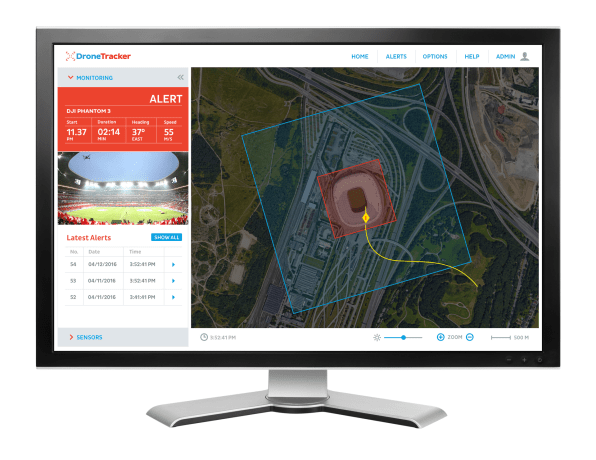
“I hope I’m wrong,” Chambers says, “but the possibilities or probabilities of a serious drone attack on a public location here in the U.S. in the next 12-18 months is extremely high. But no one’s stepping up.”
One of the problems, Dedrone believes, is that there’s little knowledge about how many drones are actually in our airspace. At a stadium, Chambers says, you might see 10 drones fly by in a month, but once you put in sensors, you discover there were actually 100. The company’s systems have identified dozens of drone flights near military installations in the nation’s capital, sometimes by the same devices.
And while we might all fear the idea of a terrorist launching an explosives-strapped drone and flying it into a stadium full of people, Dedrone’s operating assumption is that if such a thing were to happen, it would likely only happen after previous test flights meant to figure out how to thwart security. Identify a drone in a place where there shouldn’t be one, and you have information that might be used subsequently to stop an actual attack of some kind.
The system is designed to identify where the pilot is, or see where the drone landed, allowing companies’ security teams in many cases to track them and find out who’s responsible.
As Chambers puts it, the public now has plenty of experience with, and companies have taken steps to understand and deal with data breaches. But our society has no real idea how to handle a drone flying into a data center and knocking out its crucial air conditioning, or a smuggler flying a drone over a prison wall every night to deliver banned goods like drugs or weapons.
Even without the legal means to knock offending drones out of the air, having information provided by Dedrone’s technology can be a big benefit, the company argues. Imagine photographers are attempting to capture illicit images of experimental cars on a test track. The technology could identify the intruder and allow the vehicle’s owner to stop driving and set off a fog grenade. “There can be passive countermeasures,” Lamprecht says. “You don’t have to bring [the drone] down.”
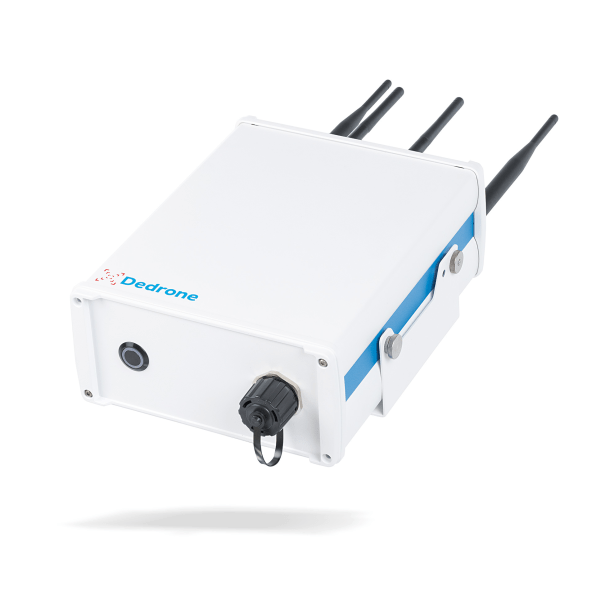
Similarly, prison officials could detect that the same drone is flying nearby every night, and could be ready and waiting for the pilot the next time he or she shows up.
There are, of course, other approaches to detecting badly-behaving drones. One being utilized by the military, known as SkySafe, examines radio-frequency waves and other signals in order to detect, identify, track, and intercept drones by more or less jamming their radios. Another, known as ApolloShield, is a $30,000-per-year system that resembles a wireless router and can detect drones flying even up to two miles above the ground.
But Dedrone says its system is more robust because it can work in any weather conditions, and at any time of day, and can tell the difference between drones and other flying objects like birds and helicopters, or even clouds and leaves. Its sensors are also meant to be updated over the Internet.
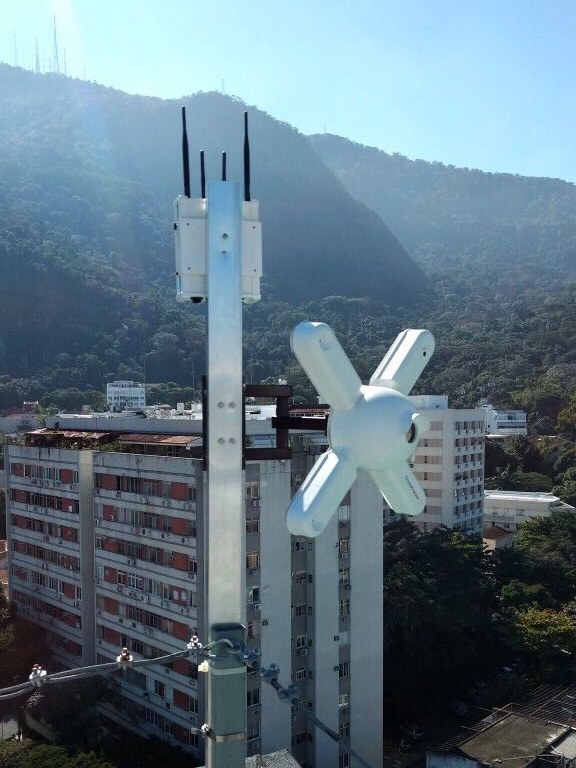
Brazil [Photo: courtesy of Dedrone]
All of that means Dedrone’s approach gives it a “two-year [advantage] over what I’ve seen on the market,” Chambers says. “Governments are saying [they] don’t have anything close, and that’s usually a good sign.”
To Ben Marcus, the CEO of drone traffic management system developer AirMap, being able to detect unknown and “potentially non-collaborative” drones is a vital piece of ensuring safe airspace for everyone, and “we’re very enthusiastic about the promise of drone detection capabilities, and we’re eager to [combined] these data sources into [our] airspace intelligence platform.”
Marcus says that although AirMap has nothing in the works with Dedrone, the two technologies could be integrated, and he’s hopeful that his company will soon be able to offer its customers a way to do so.
He also said thinks Dedrone’s approach is on the right path to solving the detection problem. “Everything I’ve seen makes a lot of sense,” he says. “They seem to be iterating quickly, and deploying their technologies with customers that are willing to engage with them. It’s still an early market, but they’ve been effective in finding groups of customers that want to pay now, and want to help Dedrone advance.”
In fact, Dedrone is announcing tomorrow that it saw its bookings grow 250% between 2016 and 2017, 350% growth in new accounts, and 10X growth in new deployments with existing customers.
Ultimately, the company says it’s providing an essential service in a world in which we know how to protect against ground-based threats, but where we’re unprepared for those that could be approaching from the air. “We inform you about what’s flying around your building,” Lamprecht says. “I believe everyone who has a fence needs an aerial equivalent.”
Fast Company , Read Full Story
(30)

